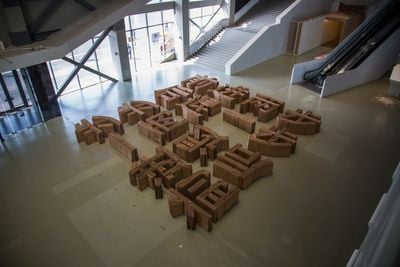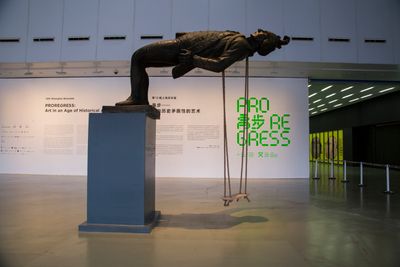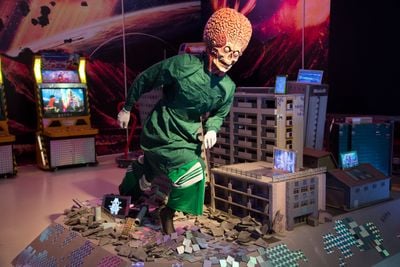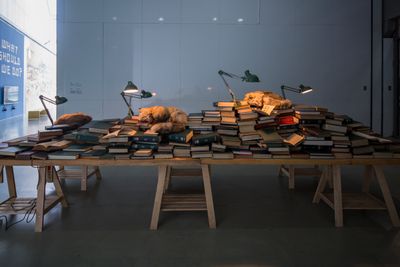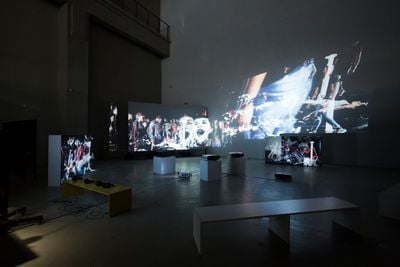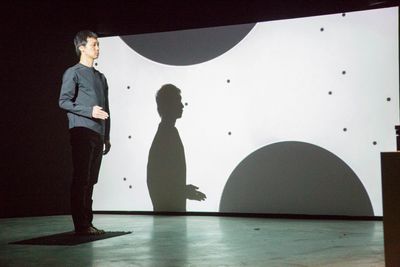Cuauhtémoc Medina
Cuauhtémoc Medina. Courtesy Shanghai Biennale.

Cuauhtémoc Medina. Courtesy Shanghai Biennale.
Launched in 1996 and now in its twelfth edition, the Shanghai Biennale is the longest-running biennial in China, presented at the Power Station of Art, China's only government-funded art space in a landscape dominated by private museums. This year's edition (10 November 2018–10 March 2019), curated by Mexican-born Cuauhtémoc Medina, brings together the work of 67 artists from 26 countries, including Nadim Abbas, Kader Attia, Chto Delat, Yang Fudong, Alfredo Jaar, and Zhang Xuzhan. Titled Proregress—Art in an Age of Historical Ambivalence, Medina borrows from poet E. E. Cummings' condensation of the words progress and regress to express 'the ambivalent condition of the world'.
Proregress considers modernity not as a linear progression, ever-expanding and improving, but as something prone to disruption by values and politics—more 'one step forwards, two steps back' than anything, as expressed by Enrique Ježik's In Hemmed-In Ground (2018), which spells out the phrase in Chinese characters on the ground floor atrium of the Power Station of Art. At its heart, Medina's curatorial premise tackles the progressivist nature of Western enlightenment narratives, shedding light on the shift of the industrial economy to the East and South, and the rise of xenophobia and right-wing movements across the world. Mexican architect Frida Escobedo enabled the articulation of the exhibition's narrative through a format based on a series of corridors, which act as the 'spine' to the spaces where artworks are placed and lend to the cadence of the overall viewing experience, whilst accentuating the discordant nature of contemporary experience.
Beyond the Power Station of Art, the Biennale's integral City Projects are present across various sites, including Sinan Mansions, Tank Shanghai, and the Swatch Art Peace Hotel, where Taiwanese artist Yao Jui-chung is exhibiting 'Incarnation' (2017), a black and white photographic series in which sculptures of deities are captured in barren urban landscapes. Launched in 2012, City Projects aims to highlight the unique urban context of the Biennale whilst garnering public interest and further embedding the exhibition into the city's cultural fabric.
Since 2013, Medina has served as chief curator at the Museo Universitario Arte Contemporáneo (MUAC) in Mexico City. Between 2002 and 2008, he was the first associate curator of Latin American Art Collections at the Tate Modern. He has organised a wealth of exhibitions and projects, including Francis Alÿs' performance When Faith Moves Mountains (Lima, Peru, 2001); The Age of Discrepancies, Art and Visual Culture in Mexico 1968–1997 at MUCA, Universidad Nacional Autónoma de México (2007); and Teresa Margolles' project for the Mexican Pavilion at the 53rd Venice Biennale 2009. In 2012, he was head curator of Manifesta 9 in Genk, Belgium, titled The Deep of the Modern.
DdThe title of this edition of the Shanghai Biennale is taken from E. E. Cummings' concept of 'proregression', which he coined in his 1931 collection of experimental poems, 'ViVa'. Why did you choose to focus on this particular idea as your thematic starting point?
CMIn the spring of 2017, I decided to read all of E. E. Cummings' poetry. When I came across his texts from the early 1930s, I was astonished by one of his linguistic concoctions, the word 'proregress'. If words are tools that we prepare with a purpose in mind, but later on keep redefining with new usages, this was a forgotten tool; left forgotten in Cummings' oeuvre. I was struck by how timely it felt: it appeared to summarise the ambivalent condition of the world, torn as it is by contradictions and new ideological battles, despite the hegemony of economic thought and capitalism that keeps on revolutionising the world.
I felt 'proregress' was a word that could express the condensation of forces of advancement and reaction in our world: the ceaseless growth of capitalism in line with complex moments of political and social regression; the return of feminist movements in the midst of a growing gender violence; the prevalence of means of communication and the growing ideological and moral divides that prevail between peoples and many significant societies. I decided to use the word, and the concepts I derived from it, to make a project when I was fortunate enough to be one of the shortlisted candidates to curate the 12th Shanghai Biennale.
DdHow does this Biennale engage and respond to the many social and political challenges we are facing today, not to mention China's increasingly important geopolitical role in terms of cultural production and the global economy?
CMWe defined four issues to research in the pursuit of artists and artworks for the exhibition. One is the way, given the crisis of the political models of this era, projects of emancipation immediately turn into forms of oppression and control, and the way art and individuals respond to those issues. Another question we researched is the difficulty in distinguishing between war and peace, especially at a time when capitalism seems to keep on working under social anomie, and wars are not declared but appear to have become a perpetual feature across several regions.
We were also inspired by the way nature and society have become categories that are continuously intertwined, both in terms of the effects of industrialisation, and the changes in our understanding of humanity and nature. To all those issues, where we have a significant level of confusion and ambivalence, I added the way more productive forms of cultural and artistic production engage in non-cultural or barbaric material when researching notions of the cultural 'other'.
Given the importance of China in the making of the contemporary world, and of the Shanghai Biennale as one of the events that marked the decentralisation of the art world since the 1990s, it seemed appropriate to share a perspective with audiences that was clearly not identified with a Western position. However, the pretense that there are original cultures or traditions that are to be put into dialogue on the basis of mutual respect does not indicate a multiculturalist view. We need to develop a sophisticated, multicentred view of art and culture if we want to reach an audience that aspires to become a global citizenry that looks beyond the scope of any nation state to understand the challenges and questions of the day.
DdWhat were some of the curatorial challenges in putting together this Biennale?
CMThe main challenge was the timeframe; I was appointed exactly a year before the event. Given the fact that the content of the exhibition, as with all publications and cultural events in China, had to be reviewed and licensed by the Art Bureau, I was actually left with roughly six months of research and invention, followed by a couple of months dedicated to production. At the end of the day, having the artists' input at each step made our work possible. Our colleagues at the Power Station of Art are used to producing exhibitions with amazing speed; the installation itself took less than two weeks.
DdWhat was the selection process of artists like? What were you looking for?
CMSince we only had a year, I first invited 15 artists with whom I have a significant relationship, in the hope we could develop some ideas for new commissions early on. Then I used the end of 2017 and early 2018 to research and visit the studios of artists in several cities across Greater China, on the basis of suggestions from different sources, once again based on our project. Simultaneously, I asked my three associate curators, Yukie Kamiya, Weiwei Wang and María Belén Sáez de Ibarra, to do research and make proposals of their own, both in terms of certain thematic lines they were each investigating, but also for the rest of us. It was an organic process, where no artist was invited unless their inclusion was agreed upon with another curator. In fact, we took advantage of a number of meetings and openings in February in Mexico to convene and work from a different geography. Having a diverse curatorial team and a complex process of research allowed us to utilise the possibilities of the Biennale in full.
DdIn many cases, biennial exhibitions have become a mere symbol of a modern city: a boon for cultural tourism. What distinguishes this biennial from others, other than its location?
CMUnlike many other colleagues, I am very much in favour of biennials and the way they keep forcing a decentring of the art world, and the space for forms of artistic practice that are political and social in kind, precisely because they are meant to interpellate a geography and an audience. In that sense, I see the Shanghai Biennale as one of the institutions that has provoked geopolitical changes in global art since the 1990s. Because of this, the task of curating a biennial exhibition implies a relation to a history that encompasses a critical pursuit of a more complex artistic narrative around the world. Both the Shanghai Biennale's international committee, which selects curators, and the curators that are ultimately appointed, continue to consider this particular Biennale as being among a handful for which the pursuit of criticality in contemporary art, and the cause of looking for a proper cosmopolitan outlook in today's world, are renewed and energised every two years.
In my view, the crisis of the biennial is gravely exaggerated—they keep on emerging all over the place, in different sizes and forms. Most concerns are mystified: they frequently reflect, instead, the discomfort that a sector of the art world has with the fact that our world has expanded, that artworks cannot recover their past geographical and conceptual naivety, and that no one can pretend to stand on top of contemporary culture, simply because you cannot witness all these events that are being staged simultaneously. In that sense, I do not think there is so much a shared 'challenge' as there is the possibility to endorse with enthusiasm the fact that biennial shows keep challenging our cultural provincialism and our nostalgia for a more cosy cultural geography.
DdHow does the Shanghai Biennale engage with Chinese audiences?
CMLet me point out that the numbers of visitors and their enthusiasm in the Biennale's first week speaks for itself. This is a biennial that is voted for by people using their feet. That gives me great joy. There are a number of ways we prepared the exhibition mostly with Chinese audiences in mind—the critical reader we published in time for the opening, for example, is exclusively in Chinese, with texts and artworks made to ensure that the local audience is able to follow the argument more closely than foreign visitors. We also defined a Chinese parallel concept of the show in relation to Yubu—a sacred Daoist dance that involves swinging back and forth. All of these elements relate to our understanding that this is an exhibition with a significant local audience and not a project for international visitors and critics. The Shanghai Biennale has a significant role in terms of offering space for public thought. Art today operates frequently as a parallel 'public sphere' addressing public issues in a different language and perspective. Even the encrypted elements in the works and their allusions were made with the hope to offer an object for local consumption.
DdHow do you maintain the balance between the local and the global?
CMIt is my belief that audiences and artists are increasingly comfortable with the way the local and global are not identities in need of any special care, but are perspectives that a single artwork, sentence or image can activate in us. I am suggesting that we are doppelgängers—that, rather than embodying a Dr. Jekyll and Mr. Hyde dichotomy, we harbour forms of culture that are rooted in cities and towns, and can be projected to a planetary scale without much adaptation. My point is that global art is frequently made of particular stories and references that do not need to be projected to an abstract plane to become relevant to a distant viewer.
Similarly, the nation is no longer the main referent of our cultural identity: we frequently locate the significance of our production in an undefined space between our neighbourhood and the global networks we are part of. That includes the fact that misunderstandings are also culturally productive because in our cultural interactions we do not expect a correct translation to engage in dialogue. We mix the parochial and the global, without needing to pretend that we aspire to any universal language, either in terms of form or concept. In that sense, one might prefer to say that the relationship between the local and the global is not so much a matter of balance between those concepts, but something more closely related to a dance. —[O]


